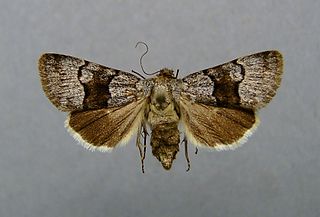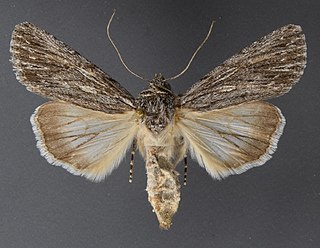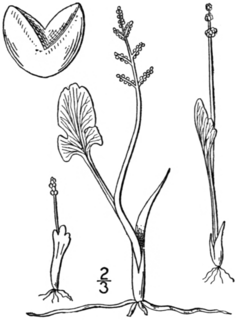
The sand martin or European sand martin, bank swallow in the Americas, and collared sand martin in India, is a migratory passerine bird in the swallow family. It has a wide range in summer, embracing practically the whole of Europe and the Mediterranean countries and across the Palearctic to the Pacific Ocean. It is a Holarctic species also found in North America. It winters in eastern and southern Africa, South America, and the Indian Subcontinent.

The Connecticut River is the longest river in the New England region of the United States, flowing roughly southward for 406 miles (653 km) through four states. It rises at the U.S. border with Quebec, Canada, and discharges at Long Island Sound. Its watershed encompasses 11,260 square miles (29,200 km2), covering parts of five U.S. states and one Canadian province, via 148 tributaries, 38 of which are major rivers. It produces 70% of Long Island Sound's fresh water, discharging at 18,400 cubic feet (520 m3) per second.

Acronicta lanceolaria, the lanceolate dagger moth or pointed dagger, is a moth of the family Noctuidae. The species was first described by Augustus Radcliffe Grote in 1875. It is found in North America, from Nova Scotia to British Columbia. It is listed as a species of special concern and believed extirpated in the US state of Connecticut.

Sympistis is a genus of moths of the family Noctuidae. The genus was erected by Jacob Hübner in 1823.

Sympistis aqualis is a moth of the family Noctuidae first described by Augustus Radcliffe Grote in 1881. It is found in North America. It was formerly considered a subspecies of Oncocnemis riparia, but was elevated to species status and transferred to the genus Sympistis in 2008.

Sympistis major is a moth of the family Noctuidae first described by Augustus Radcliffe Grote in 1881. It is widely distributed in the Pacific Northwest of North America. It was formerly known as Oncocnemis riparia major, a subspecies of Oncocnemis riparia, but was elevated to species level as Oncocnemis major in 1999 and transferred to the genus Sympistis in 2008.
Sympistis figurata is a moth of the family Noctuidae first described by Leon F. Harvey in 1875. It is found in the United States east of the Cascade Range in Washington and Oregon.

Agrotis stigmosa is a moth of the family Noctuidae first described by Herbert Knowles Morrison in 1875. It is found in North America from New England and Quebec west to Colorado and eastern Alberta. It is listed as a species of special concern in the US state of Connecticut.

Apamea inordinata is a moth of the family Noctuidae. It is found in the United States, including New York, Massachusetts, Pennsylvania, Colorado, and California. In Canada it is found in Ontario, Quebec, New Brunswick, Nova Scotia, British Columbia, Alberta, Saskatchewan and Manitoba. Its wingspan is about 34 mm. The species is listed as threatened in Connecticut.

Chlosyne harrisii, or Harris's checkerspot, is a member of the family Nymphalidae that is found in North America. They range from the Canadian Atlantic provinces, excluding Newfoundland and Labrador, to Manitoba and North Dakota south to West Virginia and Ohio. They can often be seen in bogs, meadows and almost anywhere else its host plant occurs. The typical elevations for this species range from 0 to 1,742 feet (531 m). It is listed as a species of special concern and believed extirpated in the US state of Connecticut.

Lake Zoar is a reservoir on the Housatonic River in the U.S. state of Connecticut. It was formed by the completion of the Stevenson Dam, which flooded an area of Oxford and Stevenson named "Pleasantvale" or "Pleasant Vale". "Connecticut's Lakes Reflect Our History, Present". Retrieved 2018-04-02. The towns of Monroe, Newtown, Oxford, and Southbury border Lake Zoar. The name Zoar originates from corner of Newtown and Monroe that once called itself Zoar after the Biblical city Zoara near the Dead Sea.
Hollandaea is a small genus of plants in the family Proteaceae containing four species of Australian rainforest trees. All four species are endemic to restricted areas of the Wet Tropics of northeast Queensland.

Botrychium simplex, the little grapefern, is a species of fern in the family Ophioglossaceae that is native to North America and Greenland. It is a perennial.
Sympistis dentata, the toothed apharetra moth, is a moth of the family Noctuidae described by Augustus Radcliffe Grote in 1875. It is found from Yukon, the Northwest Territories, and British Columbia to Newfoundland and the northern United States, south in the east to New Jersey. It is listed as threatened in the US state of Connecticut. The habitat consists of acidic spruce bogs and swamps, pine-oak barrens on sandplains, rocky summits and ridges.
Eucosma morrisoni, or Morrison's mosaic, is a species of moth of the family Tortricidae described by Thomas de Grey, 6th Baron Walsingham in 1884. It is found in western states North America and from Washington east to Michigan. The species is listed as threatened in the US state of Connecticut.

Sympistis infixa, the broad-lined sallow moth, is a moth in the family Noctuidae. It was described by Francis Walker in 1856 and is found in North America.
Sympistis perscripta, the scribbled sallow moth is a moth of the family Noctuidae that is native to North America. It is listed as a species of special concern in the US states of Connecticut and Massachusetts. It was described by Achille Guenée in 1852. The larval hosts are Antirrhinum, Linaria, and Nuttallanthus.
Sympistis kelsoensis is a species of moth in the family Noctuidae. It is found in North America.

Rex Brasher was an American watercolor painter and ornithologist in the vein of John James Audubon and Louis Agassiz Fuertes. Brasher's 875 surviving paintings depicted 1,200 species and sub-species of North American birds with unsurpassed accuracy and detail, representing all the species and sub-species identified in the American Ornithologists’ Union’s Checklist of North American Birds.











